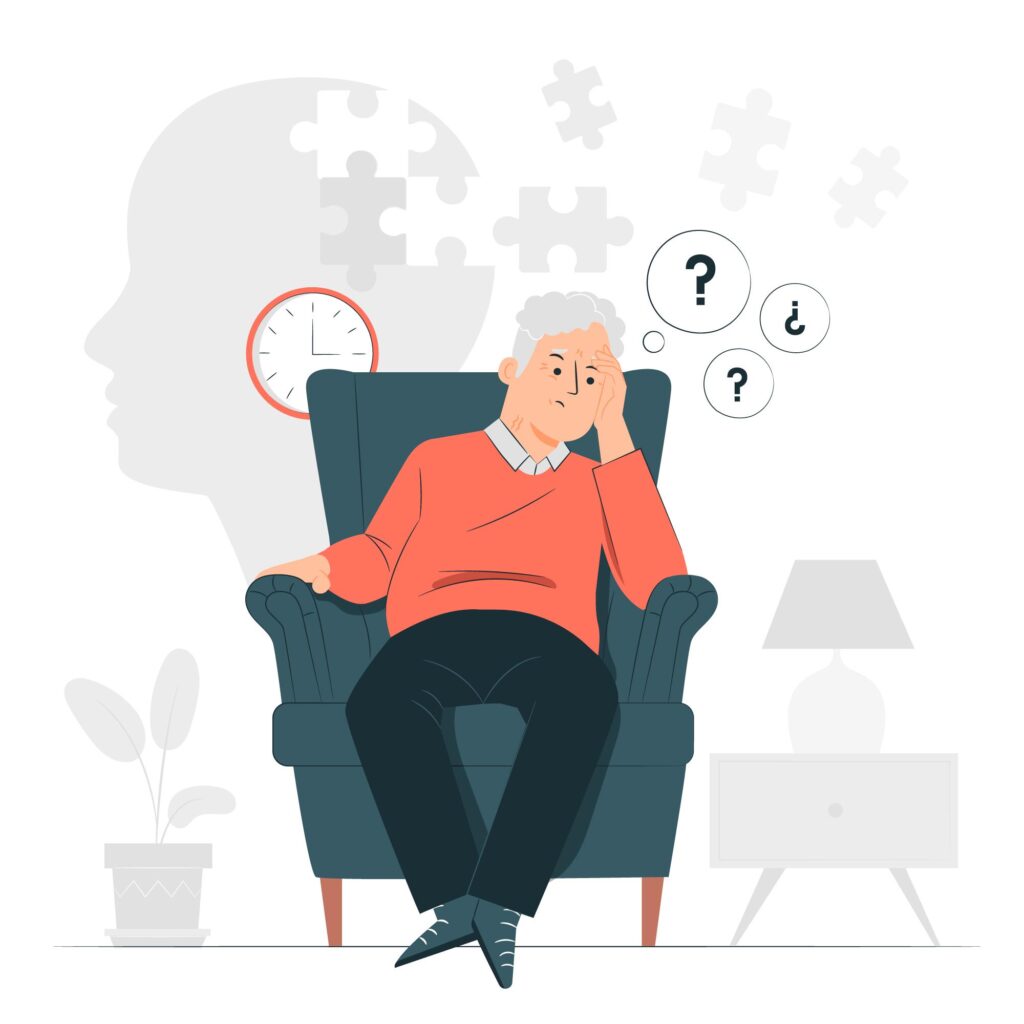Alzheimer’s Disease
Quick Overview :
- Progressive Neurodegenerative Disorder: Alzheimer’s disease is a common brain disorder causing memory loss and cognitive decline.
- Most Common Form of Dementia: It is the leading cause of dementia, affecting millions worldwide.
- Brain Changes: Alzheimer’s is characterized by abnormal protein buildup in the brain, disrupting neuronal function and causing cell death.
- Risk Factors: Advanced age, genetics, and lifestyle play roles in its development.
- Symptoms: Memory loss, language problems, disorientation, mood changes, and impaired reasoning are common symptoms.
- Diagnosis: Diagnosis involves medical history, cognitive tests, and brain imaging.
What is Alzheimer’s Disease?
Alzheimer’s disease is a progressive neurodegenerative disorder that affects the brain, leading to memory loss, cognitive decline, and changes in behavior. It is the most common cause of dementia. Alzheimer’s is characterized by the accumulation of abnormal proteins in the brain, which disrupt neuronal function and lead to brain cell degeneration.

Causes and Risk Factors:
1. Genetic Factors:
- Familial Alzheimer’s Disease: Inherited genetic mutations in specific genes such as APP, PSEN1, and PSEN2 can increase the risk of developing Alzheimer’s disease.
- Apolipoprotein E (APOE) Gene: Variants of the APOE gene, particularly the APOE ε4 allele, are associated with an increased risk of developing late-onset Alzheimer’s disease.
2. Age:
- Advancing Age: Age is the single most significant risk factor for Alzheimer’s disease, with the prevalence increasing exponentially after the age of 65. The risk doubles every five years after age 65.
3. Lifestyle and Environmental Factors:
- Cardiovascular Health: Conditions that affect cardiovascular health, such as hypertension, diabetes, obesity, and high cholesterol, may increase the risk of Alzheimer’s disease.
- Smoking and Alcohol Consumption: Smoking and excessive alcohol consumption have been linked to an increased risk of cognitive decline and Alzheimer’s disease.
- Head Trauma: Severe head injuries, especially those resulting in loss of consciousness, may increase the risk of developing Alzheimer’s disease later in life.
4. Brain Changes and Protein Abnormalities:
- Beta-Amyloid Plaques: Accumulation of beta-amyloid protein fragments outside neurons in the brain, forming plaques, is a hallmark characteristic of Alzheimer’s disease.
- Tau Protein Tangles: Abnormal accumulation of tau protein within neurons, forming tangles, disrupts cellular function and contributes to neuronal death and cognitive decline.
5. Inflammatory and Immune Responses:
- Chronic Inflammation: Chronic inflammation in the brain, resulting from immune system dysregulation or underlying health conditions, may contribute to the development and progression of Alzheimer’s disease.
- Microglial Activation: Dysfunctional microglial cells, the brain’s resident immune cells, may play a role in exacerbating neuroinflammation and neuronal damage in Alzheimer’s disease.
Pathophysiology:
Alzheimer’s disease is characterized by the accumulation of abnormal protein deposits in the brain, including beta-amyloid plaques and tau tangles. These protein aggregates disrupt neuronal communication and lead to the progressive degeneration of brain tissue, particularly in regions responsible for memory and cognition.
What are the Symptoms of Alzheimer’s?
1. Mild Cognitive Impairment:
- Forgetfulness: Difficulty recalling recent events, appointments, or conversations.
- Trouble with Language: Difficulty finding the right words, following conversations, or understanding written information.
- Impaired Judgement: Poor decision-making or difficulty solving problems.
- Reduced Spatial Awareness: Getting lost in familiar places or having trouble with directions.
2. Progressive Memory Loss:
- Short-Term Memory Loss: Forgetting recent information such as where items were placed or recent conversations.
- Long-Term Memory Loss: Difficulty remembering past events, experiences, or personal details.
3. Disorientation and Confusion:
- Temporal and Spatial Disorientation: Losing track of time, dates, or seasons. Getting disoriented in familiar places.
- Person Disorientation: Forgetting the names or identities of family members or close friends.
- Situation Disorientation: Becoming confused about current events or circumstances.
4. Changes in Behavior and Personality:
- Mood Swings: Fluctuations in mood, including irritability, agitation, anxiety, or depression.
- Social Withdrawal: Loss of interest in social activities or hobbies previously enjoyed.
- Increased Apathy: Lack of motivation or interest in participating in daily activities.
5. Decline in Executive Function:
- Impaired Planning and Organization: Difficulty planning or organizing tasks, managing finances, or following recipes.
- Reduced Problem-Solving Abilities: Trouble with problem-solving, decision-making, or logical reasoning.
- Lack of Initiative: Decreased initiative to start or complete tasks, leading to dependency on others for assistance.
6. Motor Symptoms:
- Motor Coordination: Decline in motor coordination, leading to difficulty with activities such as dressing, grooming, or writing.
- Gait Abnormalities: Changes in walking pattern, balance, or coordination, increasing the risk of falls.
Diagnosis :
Diagnosing Alzheimer’s disease involves a comprehensive evaluation of medical history, physical examination, cognitive assessments, and laboratory tests. Neuroimaging techniques such as MRI and PET scans can help detect structural and functional changes in the brain associated with Alzheimer’s disease.
Treatment :
Treatment of Alzheimer’s Disease: Strategies for Management
1. Pharmacological Interventions:
- Cholinesterase Inhibitors:
- Donepezil (Aricept), Rivastigmine (Exelon), Galantamine (Razadyne): These medications enhance levels of acetylcholine, a neurotransmitter involved in memory and cognition.
- Dosage: Initial doses are typically low and gradually increased over time, as tolerated.
- Memantine (Namenda):
- Memantine is an NMDA receptor antagonist that regulates glutamate activity in the brain, helping to improve cognitive function.
- Dosage: Starting dose is usually low and titrated upwards based on individual response and tolerance.
2. Non-Pharmacological Interventions:
- Cognitive Stimulation:
- Engaging in activities that stimulate cognitive function, such as puzzles, games, and memory exercises, can help maintain cognitive abilities and improve quality of life.
- Physical Exercise:
- Regular physical activity, including aerobic exercise, strength training, and balance exercises, may help improve mood, cognition, and overall well-being.
- Nutritional Support:
- A balanced diet rich in fruits, vegetables, whole grains, and healthy fats can support brain health and cognitive function.
- Omega-3 fatty acids and antioxidants may have neuroprotective effects and reduce inflammation in the brain.
3. Supportive Care and Services:
- Caregiver Support:
- Providing education, counseling, and respite services for caregivers can alleviate stress and burnout associated with caring for individuals with Alzheimer’s disease.
- Day Care Programs:
- Day care programs offer structured activities, socialization, and supervision for individuals with Alzheimer’s disease, providing much-needed support for caregivers.
- Memory Care Facilities:
- Memory care facilities offer specialized care and support tailored to the needs of individuals with Alzheimer’s disease, providing a safe and supportive environment.
4. Clinical Trials and Investigational Therapies:
- Research Opportunities:
- Participation in clinical trials and research studies offers access to investigational therapies and contributes to advancements in Alzheimer’s disease treatment and understanding.
- Trials may evaluate novel drug therapies, lifestyle interventions, and biomarkers for early detection and intervention.
5. Symptom Management:
- Behavioral and Psychological Symptoms:
- Addressing behavioral symptoms such as agitation, aggression, and sleep disturbances may require non-pharmacological interventions, including behavioral therapy and environmental modifications.
- Depression and Anxiety:
- Managing mood disorders with antidepressant medications, psychotherapy, and supportive interventions can improve overall well-being and quality of life.
6. Regular Monitoring and Adjustments:
- Ongoing Evaluation:
- Regular follow-up visits with healthcare providers allow for monitoring of disease progression, treatment efficacy, and potential side effects of medications.
- Treatment plans may need to be adjusted based on individual response, tolerance, and changes in disease status.
Conclusion:
Alzheimer’s disease presents profound challenges for individuals, families, and society, underscoring the urgent need for continued research, advocacy, and support. By advancing our understanding of Alzheimer’s disease and developing effective interventions, we can strive to improve outcomes and enhance the quality of life for those affected by this devastating condition.


Pingback: common health conditions - AcconstHost
Pingback: Common health conditions - MedWebMD